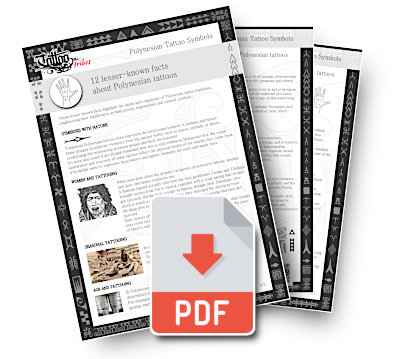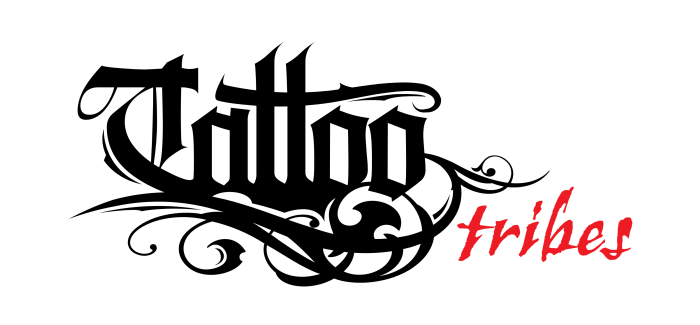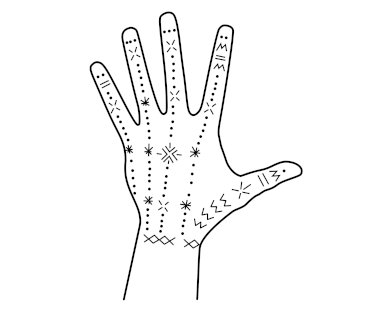These lesser-known facts highlight the depth and complexity of Polynesian tattoo traditions, emphasizing their significance as both artistic expressions and cultural symbols.
Symbiosis with Nature

Traditional Polynesian tattoos often represent the interconnectedness of humans and nature. Many designs incorporate elements from the natural world, such as waves, animals, or plants, symbolizing the relationship between people and their environment.
It's been also noted (Lars Krutak remarked how this is still evident in Melanesia) how the visual appearance and structure of some tattoos reflect the physical reality of the islands they come from, with darker parts to represent deep waters and lighter elements for reefs and sandy bars.
Women and Tattooing
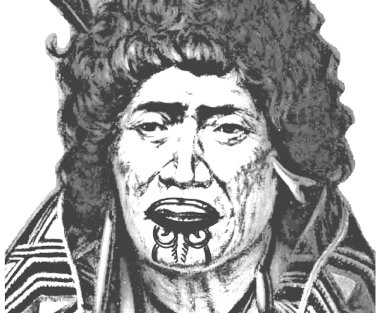
While men were often the primary recipients of extensive tattoos, women had their own tattoo traditions too.
A Samoan legend actually tells how the twin goddesses Taema and Tilafaiga brought tattoos from Fiji to Samoa, together with a song saying that women got tattooed. During their voyage to Samoa, though, near Falealupo, they dived to reach a giant clam, and when they emerged the dizziness from the deep dive resulted in the song being changed to saying that men got tattooed.
Male tattoos often include symbols related to warrior qualities, while female ones often relate to the position held within the community, as in the case of Maori's Moko Kauae, and to protection, as for the Samoan Malu.
Seasonal Tattooing
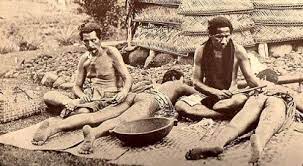
In some Polynesian societies, tattooing was a seasonal practice, often coinciding with specific cultural or religious ceremonies. The timing and context of tattooing were deeply connected to cultural calendars and community traditions.
Pain and Endurance
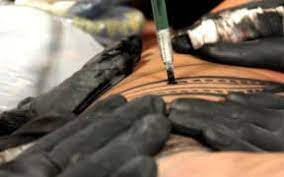
In Polynesian cultures, enduring the pain of tattooing was seen as a rite of passage, demonstrating one's strength, resilience, and commitment to the community and cultural traditions.
In Samoan society, not having a traditional tattoo is not as bad as having an unfinished one: if a man can't stand the pain of the traditional pe'a tattoo, he can't be trusted to hold his position in war even if injured, and this would bring shame on him as well as on his whole family. The term indicating such a person is pe'a ma'i, meaning "incomplete pe'a." It's worth noting that ma'i can also be translated as "sick," which accentuates the negative connotation of this.
Taboos

There were often taboos or restrictions associated with certain tattoo designs or practices. For example, some designs were reserved for individuals of specific status or lineage, and it would be culturally inappropriate for others to adopt those designs without proper authorization or understanding.
Also, being tattooing a sacred practice (tapu, from where the word "taboo" comes, originally means "sacred" and therefore with restrictions), people receiving them should avoid contact with certain foods or engaging in specific activities until the tattoo was healed and the tapu lifted.
Influence of Migrations
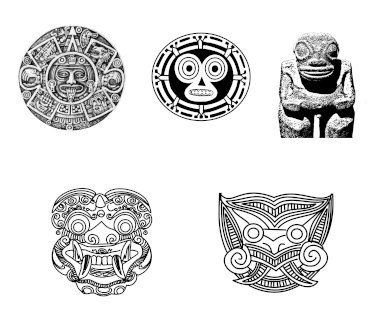
Polynesian tattoo designs and techniques evolved over centuries, influenced by migrations, interactions with other cultures, and the dynamic exchange of ideas and artistic styles across the Pacific region, and the same happened to Polynesian languages.
Hawaii, being the most remote archipelago, shows a simpler style, closer to the original Lapita designs, and a language closer to the original proto-Polynesian, while Maori designs and language show a higher degree of decorative effort, with influences from South-Asian cultures.
Symbolism of Spaces
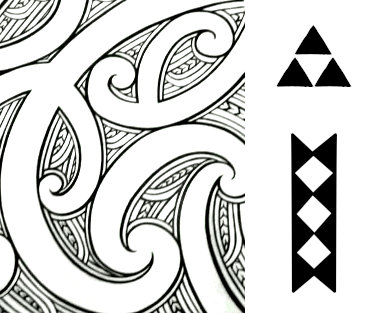
In Polynesian tattoo designs, the spaces between the patterns and motifs (negative spaces) were as significant as the inked areas. These spaces often carried symbolic meanings, representing concepts like balance, harmony, or the interconnectedness of life.
This is particularly true in Maori tattooing, but there are several examples in other traditions too, as in the Hawaiian lōkahi and kuhanu symbols where the negative space between the black parts represents light coming out of darkness in a balancing act.
Age and Tattooing
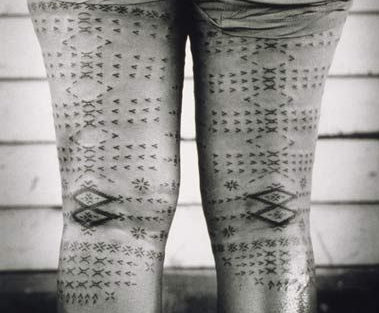
In Polynesian cultures, the age at which one received tattoos was determined by specific cultural or social milestones rather than a set age. For example, tattoos might be received upon reaching adulthood, getting married, or achieving a particular status within the community.
Tattooing and Healing
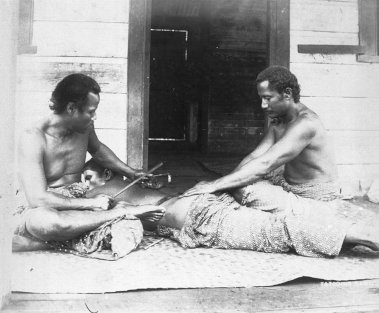
Traditional Polynesian tattoo artists (tufuga ta tatau in Samoa) were often revered members of their communities, possessing not only artistic skills but also knowledge of healing arts, spiritual rituals, and cultural traditions associated with tattooing.
This knowledge is passed on from father to son, and specific families carry on the tradition through the generations, as in the case of the Suluape family in Samoa.
Traditional Ceremonies
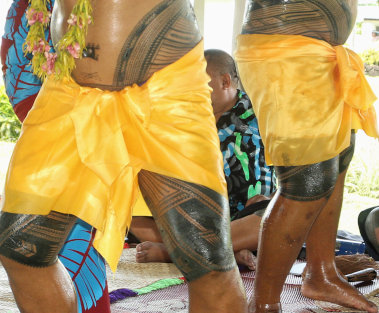
The process of receiving a traditional tattoo is accompanied by specific ceremonies, rituals, and protocols that reinforce its cultural significance. These ceremonies often involve family members, elders, and the wider community, emphasizing the communal nature of the tattooing process and strengthening the bond between all participants.
Since receiving a pe'a tattoo is a complex and expensive attainment, it is usually organized for two or more people at a time, usually relatives, so that some costs are shared, and even if one person draws back, the tattoo master still has the other to work on. Being together also acts as an encouragement, lowering the chances of someone quitting.
The use of oil and turmeric during the ceremony of the presentation of the pe'a is not only symbolic, but also practical, as oil keeps the skin elastic and turmeric is a natural antiseptic, which limits the risk of infections.
Aftercare
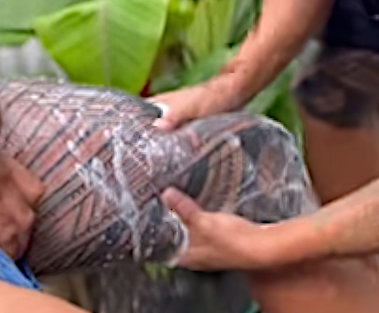
After a Samoan male tattoo, or pe'a, is completed, it requires showering and massaging it several times a day until healing, to squeeze out the ink in excess. Also, massaging the tattooed areas helps to increase blood circulation, which can aid in the healing process. By manipulating the skin and underlying tissues, the tattoo master can help reduce swelling and alleviate discomfort (even if massaging is actually more painful than the tattooing itself), while helping the ink to settle evenly throughout the skin, ensuring that the tattoo retains its sharp details as it heals.
These fascinating facts give us a deeper appreciation for the rich history and cultural weight behind every traditional Polynesian tattoo.
